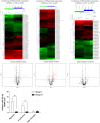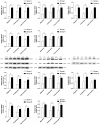MicroRNA-223-3p inhibits the angiogenesis of ischemic cardiac microvascular endothelial cells via affecting RPS6KB1/hif-1a signal pathway
- PMID: 25313822
- PMCID: PMC4196764
- DOI: 10.1371/journal.pone.0108468
MicroRNA-223-3p inhibits the angiogenesis of ischemic cardiac microvascular endothelial cells via affecting RPS6KB1/hif-1a signal pathway
Abstract
Background: MicroRNAs (miRNAs) are a recently discovered class of posttranscriptional regulators of gene expression with critical functions in the angiogenesis and cardiovascular diseases; however, the details of miRNAs regulating mechanism of angiogenesis of ischemic cardiac microvascular endothelial cells (CMECs) are not yet reported.
Methods and results: This study analyzes the changes of the dynamic expression of miRNAs during the process of angiogenesis of ischemic CMECs by applying miRNA chip and real-time PCR for the first time. Compared with normal CMECs, ischemic CMECs have a specific miRNAs expression profile, in which mir-223-3p has the most significant up-regulation, especially during the process of migration and proliferation, while the up-regulation is the most significant during migration, reaching 11.02 times. Rps6kb1 is identified as a potential direct and functional target of mir-223-3p by applying bioinformatic prediction, real-time PCR and Western blot. Pathway analysis report indicates Rps6kb1 regulates the angiogenesis by participating into hif-1a signal pathway. Further analysis reveals that both the gene and protein expression of the downstream molecules VEGF, MAPK, PI3K and Akt of Rps6kb1/hif-1a signal pathway decrease significantly during the process of migration and proliferation in the ischemic CMECs. Therefore, it is confirmed that mir-223-3p inhibits the angiogenesis of CMECs, at least partly, via intervening RPS6KB1/hif-1a signal pathway and affecting the process of migration and proliferation.
Conclusion: This study elucidates the miRNA regulating law in the angiogenesis of CMECs; mir-223-3p inhibits the process of migration and proliferation of ischemic CMECs probably via affecting RPS6KB1/hif-1a signal pathway, which in turn suppresses the angiogenesis. It is highly possible that mir-223-3p becomes a novel intervention core target in the treatment of angiogenesis of ischemic heart diseases.
Conflict of interest statement
Figures







Similar articles
-
Qi-Shen-Yi-Qi Dripping Pills Promote Angiogenesis of Ischemic Cardiac Microvascular Endothelial Cells by Regulating MicroRNA-223-3p Expression.Evid Based Complement Alternat Med. 2016;2016:5057328. doi: 10.1155/2016/5057328. Epub 2016 Feb 15. Evid Based Complement Alternat Med. 2016. PMID: 27057198 Free PMC article.
-
[MicroRNA-223-3p inhibits the angiogenesis of ischemic myocardial microvascular endothelial cells via modulating Rps6kb1/HIF-1α signal pathway].Zhonghua Xin Xue Guan Bing Za Zhi. 2014 Dec;42(12):1039-47. Zhonghua Xin Xue Guan Bing Za Zhi. 2014. PMID: 25623352 Chinese.
-
[Involvement of miR-126-3p via mTOR/HIF-1α signaling pathway in effect of electroacupuncture on angiogenesis in rats with cerebral ischemia].Zhen Ci Yan Jiu. 2022 Sep 25;47(9):749-58. doi: 10.13702/j.1000-0607.20211281. Zhen Ci Yan Jiu. 2022. PMID: 36153449 Chinese.
-
Regulation of angiogenesis by hypoxia: the role of microRNA.Cell Mol Biol Lett. 2013 Mar;18(1):47-57. doi: 10.2478/s11658-012-0037-0. Epub 2012 Nov 3. Cell Mol Biol Lett. 2013. PMID: 23124858 Free PMC article. Review.
-
The regulatory role of microRNAs in angiogenesis-related diseases.J Cell Mol Med. 2018 Oct;22(10):4568-4587. doi: 10.1111/jcmm.13700. Epub 2018 Jun 29. J Cell Mol Med. 2018. PMID: 29956461 Free PMC article. Review.
Cited by
-
Hyperphosphorylation of RPS6KB1, rather than overexpression, predicts worse prognosis in non-small cell lung cancer patients.PLoS One. 2017 Aug 9;12(8):e0182891. doi: 10.1371/journal.pone.0182891. eCollection 2017. PLoS One. 2017. PMID: 28792981 Free PMC article.
-
Qi-Shen-Yi-Qi Dripping Pills Promote Angiogenesis of Ischemic Cardiac Microvascular Endothelial Cells by Regulating MicroRNA-223-3p Expression.Evid Based Complement Alternat Med. 2016;2016:5057328. doi: 10.1155/2016/5057328. Epub 2016 Feb 15. Evid Based Complement Alternat Med. 2016. PMID: 27057198 Free PMC article.
-
Technically Challenging Percutaneous Interventions of Chronic Total Occlusions Are Associated with Enhanced Platelet Activation.J Clin Med. 2023 Oct 29;12(21):6829. doi: 10.3390/jcm12216829. J Clin Med. 2023. PMID: 37959293 Free PMC article.
-
Cell type-specific microRNA therapies for myocardial infarction.Sci Transl Med. 2021 Feb 10;13(580):eabd0914. doi: 10.1126/scitranslmed.abd0914. Sci Transl Med. 2021. PMID: 33568517 Free PMC article. Review.
-
Inhibition of Exo-miR-19a-3p derived from cardiomyocytes promotes angiogenesis and improves heart function in mice with myocardial infarction via targeting HIF-1α.Aging (Albany NY). 2020 Dec 11;12(23):23609-23618. doi: 10.18632/aging.103563. Epub 2020 Dec 11. Aging (Albany NY). 2020. PMID: 33352533 Free PMC article.
References
-
- Filipowicz W, Bhattacharyya SN, Sonenberg N (2008) Mechanisms of post-transcriptional regulation by microRNAs: are the answers in sight. Nat Rev Genet 9 2: 102–114. - PubMed
-
- Lewis BP, Burge CB, Bartel DP (2005) Conserved seed pairing, often flanked by adenosines, indicates that thousands of human genes are microRNA targets. Ceel 120 1: 15–20. - PubMed
Publication types
MeSH terms
Substances
LinkOut - more resources
Full Text Sources
Other Literature Sources

